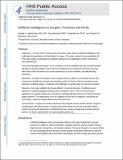Artificial Intelligence in Surgery: Promises and Perils
Author(s)
Hashimoto, Daniel A.; Rosman, Guy; Rus, Daniela L; Meireles, Ozanan R.
DownloadAccepted version (464.1Kb)
Terms of use
Metadata
Show full item recordAbstract
Objective: The aim of this review was to summarize major topics in artificial intelligence (AI), including their applications and limitations in surgery. This paper reviews the key capabilities of AI to help surgeons understand and critically evaluate new AI applications and to contribute to new developments. Summary Background Data: AI is composed of various subfields that each provide potential solutions to clinical problems. Each of the core subfields of AI reviewed in this piece has also been used in other industries such as the autonomous car, social networks, and deep learning computers. Methods: A review of AI papers across computer science, statistics, and medical sources was conducted to identify key concepts and techniques within AI that are driving innovation across industries, including surgery. Limitations and challenges of working with AI were also reviewed. Results: Four main subfields of AI were defined: (1) machine learning, (2) artificial neural networks, (3) natural language processing, and (4) computer vision. Their current and future applications to surgical practice were introduced, including big data analytics and clinical decision support systems. The implications of AI for surgeons and the role of surgeons in advancing the technology to optimize clinical effectiveness were discussed. Conclusions: Surgeons are well positioned to help integrate AI into modern practice. Surgeons should partner with data scientists to capture data across phases of care and to provide clinical context, for AI has the potential to revolutionize the way surgery is taught and practiced with the promise of a future optimized for the highest quality patient care.
Date issued
2018-07Department
Massachusetts Institute of Technology. Computer Science and Artificial Intelligence LaboratoryJournal
Annals of Surgery
Publisher
Ovid Technologies (Wolters Kluwer Health)
Citation
Hashimoto, Daniel A. et al. "Artificial Intelligence in Surgery: Promises and Perils." Annals of Surgery 268, 1 (July 2018): 70-76. © 2018 Wolters Kluwer Health, Inc.
Version: Author's final manuscript
ISSN
0003-4932